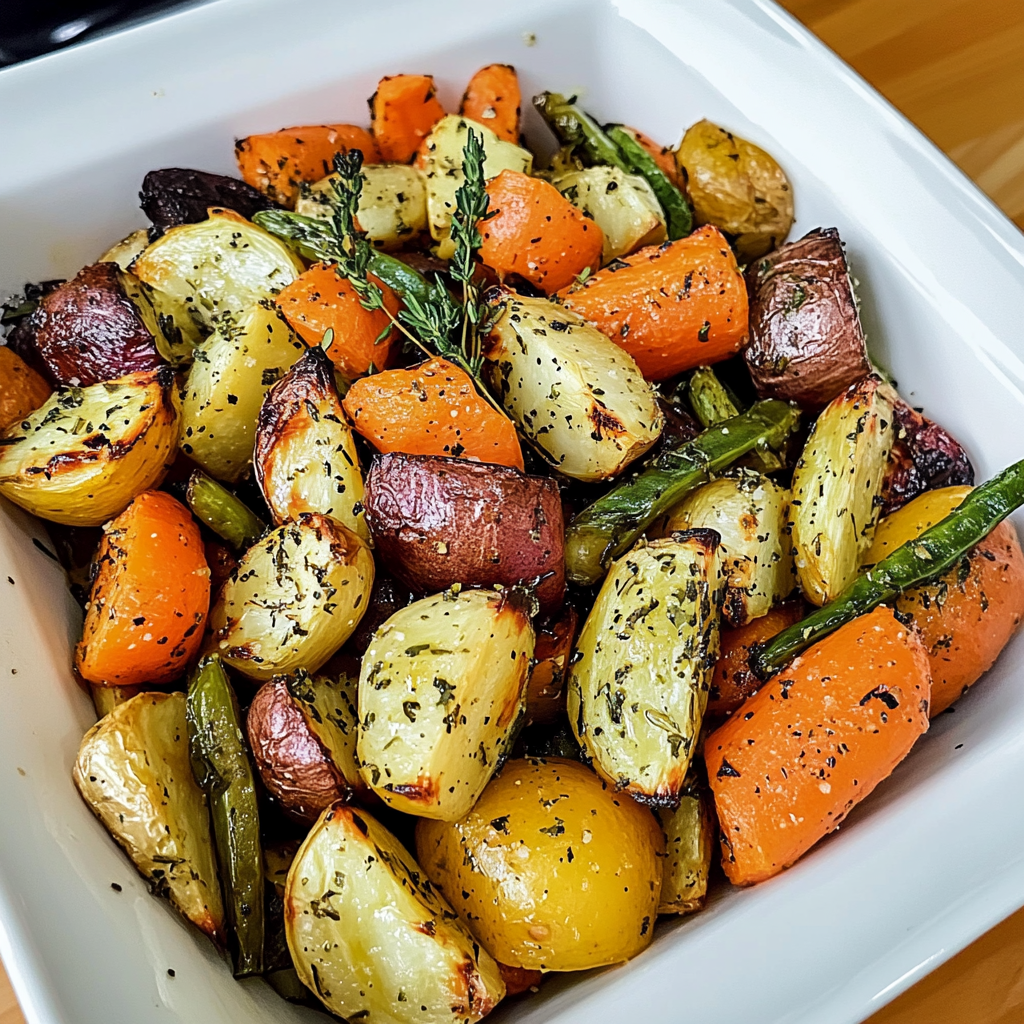
Are you looking for a simple yet healthy side dish? This garlic herb roasted vegetables recipe is perfect. It turns regular veggies into a crispy, flavorful side in under 45 minutes. It’s great for any day, whether it’s a busy weeknight or a special occasion.
This guide is for everyone, from beginners to experienced cooks. It shows how to make a colorful plate of roasted veggies. Learn how herbs and garlic can make simple ingredients taste amazing. Each step is easy to follow, focusing on taste, nutrition, and convenience.
Key Takeaways
- Roasted veggies are a healthy side dish packed with nutrients and bold flavors.
- Follow this easy vegetable recipe to cut prep time without sacrificing taste.
- Customize your roasted veggie recipe with herbs like rosemary or thyme.
- Master temperature and seasoning tips for perfectly caramelized results.
- Pair with proteins, grains, or enjoy as a vegetarian-friendly main.
Why Roasted Vegetables Should Be Your Go-To Side Dish
Looking for a side dish that’s both healthy and easy to make? Roasted vegetables are a great choice. They’re packed with nutrients and save you time. Here’s why they’re a must-have on your plate.
Health Benefits at a Glance
- Roasting keeps nutrition in roasted vegetables locked in, saving vitamins like C and K.
- High-fiber healthy roasted veggies help with digestion and keep you full.
- Using little oil means fewer calories, making them a guilt-free option.
The Magic of Roasting Vegetables
Roasting turns veggies like broccoli or Brussels sprouts into crispy, sweet treats. Even kids enjoy them. “The Maillard reaction makes bland foods into something you’ll crave,” say chefs. This makes eating veggies a delightful experience.
Time-Saving Benefits for Busy Households
Prep in just 10 minutes, then roast while you do other things. You can even cook in batches for time-saving side dishes that last 3-4 days. Use leftovers in salads, wraps, or grain bowls for meals without waste. Say goodbye to last-minute side dish stress!
The Perfect Vegetables for Roasting
Choosing the right vegetables is key to a delicious roasted mix. Let’s explore the best options to make your dish stand out.
Root Vegetables: The Hearty Foundation
Root veggies like potatoes, carrots, and parsnips are great in the oven. They become tender and caramelized. Sweet potatoes or beets add natural sweetness that’s perfect with herbs. These root vegetables are the base of any roasted veggie mix.
Cruciferous All-Stars
Don’t overlook cruciferous vegetables like broccoli, cauliflower, and Brussels sprouts. Roasting turns their bitterness into a sweet flavor. Toss them with olive oil and garlic for a healthy side dish.
Colorful Bell Peppers and Other Options
Bell peppers, zucchini, and eggplant bring color and texture. Pair them with root veggies for a mix of crisp and soft. Onions and mushrooms add depth when roasted to perfection.
Seasonal Vegetable Selection Guide
Follow this seasonal roasting guide for the best flavors:
- Spring: Asparagus, peas, and new potatoes
- Summer: Eggplant, cherry tomatoes, and zucchini
- Fall: Acorn squash, butternut squash, and Brussels sprouts
- Winter: Cabbage, parsnips, and hearty greens
Using seasonal vegetables ensures freshness and saves money. Follow these tips to make meals that feel like home.
Essential Ingredients for Garlic Herb Roasted Veggies
Great roasted veggies start with the right roasted vegetable ingredients. The foundation begins with olive oil for roasting—opt for extra virgin for its rich flavor and high smoke point. Garlic transforms the dish: minced cloves add boldness, while whole cloves give milder warmth.
Fresh herbs for vegetables like rosemary, thyme, or parsley create aromatic depth. Use 1-2 tablespoons of chopped herbs. If fresh aren’t available, substitute dried herbs at half the quantity. A pinch of salt and pepper balances the mix, while red pepper flakes or lemon zest add brightness.
- Blend garlic herb seasoning with salt and pepper for a quick mix. Brands like Simply Organic offer pre-mixed options.
- Optional: drizzle with balsamic glaze or sprinkle Parmesan for texture.
- Adjust seasoning roasted vegetables by tasting as you go—start light and build flavors gradually.
Pair these basics with your favorite veggies for a versatile base. Experiment with small batches of new herbs or spices to find your favorite combo. Fresh or dried, store-bought or homemade—quality ingredients make every bite shine.
The Science Behind Perfectly Roasted Vegetables
Mastering roasting means understanding how heat changes vegetables. Let’s explore the science of vegetable caramelization and the Maillard reaction vegetables go through when cooked.
Understanding Caramelization
When veggies go into a hot oven, sugars and proteins react in a Maillard reaction vegetables process. This leads to deep flavors and golden color. For the best roasting temperature science, aim for 400°F–425°F. This range is perfect for vegetable caramelization without burning.
Preheat pans to trap heat and speed up caramelization.
- High-sugar veggies (like carrots) caramelize faster
- Pat surfaces dry before roasting to avoid steam
Moisture Control Techniques
Too much moisture can make veggies steam instead of roast. Here are ways to avoid soggy veggies:
| Technique | Why It Works |
|---|---|
| Spread veggies in a single layer | Prevents steam buildup |
| Dry veggies thoroughly | Encourages crispiness |
The Role of Oil
Oil helps conduct heat. Choose oils with high roasting temperature science smoke points like avocado oil (520°F). It also enhances proper roasting techniques by carrying flavors and adding texture. Remember, drizzle lightly to avoid greasiness.
Follow these tips for dishes that always impress.
Step-by-Step Preparation of Garlic Herb Roasted Veggies
Turn fresh veggies into golden, tasty bites with these easy steps. Follow this guide to learn how to roast vegetables evenly. You’ll make a dish that’s both simple and delicious.
Vegetable Prep and Cutting Techniques
Begin by washing and drying the veggies well. Use vegetable cutting techniques to dice root veggies into 1-inch cubes. Slice bell peppers into strips. Uniform pieces help with even cooking.
Tip: Mince garlic finely for even distribution.
The Perfect Seasoning Blend
Make a balanced flavor with herb seasoning proportions. Mix 2 tbsp olive oil, 2 minced garlic cloves, 1 tsp dried herbs (thyme, rosemary, or oregano), and a pinch of salt. First, toss veggies in oil, then add dry seasonings.
Pro tip: Shake the pan gently to coat thoroughly.
Arranging for Optimal Cooking
Spread vegetables in a single layer on a parchment-lined baking sheet—no overcrowding! This vegetable arrangement on pan ensures crispiness. For mixed veggies, group slower-cooking items (like carrots) on the pan’s edges.
Timing and Temperature Guide
Preheat your oven to 425°F (220°C) as per our roasting temperature guide. Roast for 25-35 minutes, shaking the pan halfway. Check for caramelized edges—golden brown means perfection. Adjust time for thicker cuts like sweet potatoes (+5 minutes).
Common Mistakes to Avoid When Roasting Vegetables
Getting good at roasting veggies takes time, but knowing what not to do helps a lot. Even experienced cooks can make mistakes that ruin the dish. Let’s look at the main issues to make sure every bite is just right.
- Overcrowded baking sheet: Too many veggies on one sheet can make them soggy. Make sure to leave some space between each piece.
- Uneven vegetable sizes: Big and small veggies cooked together don’t cook evenly. Cut them all to the same size for even roasting.
- Roasting temperature mistakes: If it’s too low, veggies get soft. Too high and they burn before they’re done. Aim for 400–425°F for the best results.
- Underseasoned roasted vegetables: Don’t forget to add salt and herbs. Toss them in oil and seasonings before roasting. Then, add fresh herbs after they’re done.
Save veggies that got a bit too brown by adding lemon or balsamic vinegar. It will make them taste better. Also, check the seasoning halfway through. A bit of prep and attention can make your veggies a hit!
Flavor Variations to Keep Things Interesting
Roasting vegetables is just the start—now it’s time to level up your plate. Try these flavor twists to make simple sides into crowd-pleasers every time.
Mediterranean-Inspired Herb Blends
For mediterranean roasted vegetables, mix dried oregano, basil, and thyme with lemon juice. Add crumbled feta or Kalamata olives for extra flavor. For an Italian twist, add rosemary, garlic, and red pepper flakes.
Spicy Kick Options
Crave heat? Spicy roasted vegetables are easy with these combos:
- Mild: smoked paprika + a dash of lime juice
- Bold: cayenne + honey + crushed red pepper flakes
- Global flair: harissa paste mixed with olive oil before roasting
Sweet and Savory Combinations
Pair sweet and savory vegetables like these:
| Flavor Profile | Ingredients |
|---|---|
| Maple-Glazed | Maple syrup + thyme + black pepper |
| Cinnamon-Spiced | Brown sugar + cinnamon + a pinch of nutmeg |
| Umami Blast | Soy sauce + sesame seeds + garlic powder |
Don’t stick to the same old blends! Try these herb blends for roasting and global twists (like curry powder for global flavored roasted veggies). Adjust spice levels to taste—your kitchen is your playground!
Pairing Your Roasted Veggies with Main Dishes
Make your roasted vegetables into a full meal by adding proteins, grains, or vegetarian options. These protein and vegetable pairings make dishes that are both balanced and satisfying.
Perfect Protein Pairings
- Roast chicken thighs with rosemary alongside sweet potatoes and Brussels sprouts for a savory match.
- Pair salmon with garlic-roasted asparagus and zucchini for a light, omega-3 rich meal.
- Grilled steak shines next to smoky eggplant and bell peppers for bold flavor contrasts.
Complementary Carbohydrates
Try serving roasted veggies over grains like quinoa, farro, or brown rice. This helps soak up their juices. Crusty sourdough bread is great for dipping in pan drippings.
Creating Complete Vegetarian Meals
Make your roasted vegetables into a hearty vegetarian roasted vegetable meals by adding chickpeas, lentils, or tofu. Add crumbled feta or a fried egg for extra protein. Try mixing roasted butternut squash with spinach and walnuts over greens for a complete roasted vegetable dinners.
Make-Ahead and Storage Tips for Busy Weeknights
Save time with meal prep roasted vegetables without losing flavor. Wash, cut, and store them in airtight containers up to 3 days ahead. Later, toss with oil and herbs to save morning time.
Keep roasted veggies fresh by storing them right. Cool fully roasted batches before sealing in containers. Label with dates and store in the fridge for 3-4 days. For longer storage, freeze in freezer-safe bags—portions freeze well for up to 3 months.
Reheating roasted vegetables without drying them out is simple. Try these methods:
- Oven: Bake at 375°F (190°C) for 15-20 minutes to restore crispness.
- Stovetop: Sauté in a skillet with a splash of broth for 5-7 minutes.
- Microwave: Use 30-second bursts with a damp paper towel to retain moisture.
| Vegetable Type | Freezing Tips |
|---|---|
| Broccoli/cauliflower | Blanch first, then freeze in airtight bags |
| Zucchini/eggplant | Freeze after roasting for soups or stir-fries |
| Root veggies (carrots, parsnips) | Best frozen raw; roast from frozen state |
Batch cooking vegetables weekly ensures quick weeknight vegetable side dishes. Double recipes and store portions for busy evenings. Mix reheated veggies with fresh herbs or a drizzle of balsamic glaze for a quick flavor boost. Planning ahead turns roasted veggies into reliable, no-stress meals.
Turning Leftover Roasted Vegetables Into New Meals
Turning cooked veggies into new meals is easy. A few smart tricks can make roasted veggies shine all week. Whether for lunch or dinner, these ideas make leftovers into fresh dishes easily.
Quick Lunch Ideas
Make yesterday’s roasted veggies into quick lunches with these roasted vegetable lunch ideas:
- Stir into warm grain bowls with quinoa or rice
- Layer into wraps with hummus and avocado
- Toss with greens for a hearty salad base
- Mix into eggs for a 10-minute frittata
Transformed Dinner Options
Get creative with vegetable transformations for dinner:
- Add to pasta dishes with a simple garlic-basil sauce
- Top homemade pizza dough with leftover veggies and cheese
- Blend into a savory galette or frittata crust
- Stir into creamy risotto or couscous
Roasted Vegetable Soups and Sauces
Blend roasted veggies into smooth soups or pasta sauces:
- Puree carrots and squash into a roasted vegetable soup with coconut milk
- Mash eggplant and tomatoes into a homemade pasta sauce
- Whip sweet potatoes into a spicy chili base
Leftover roasted veggies also freeze well for future leftover roasted vegetable recipes. Just label containers and enjoy meal prep without guilt!
Ingredients
1 lb baby potatoes (red or gold), halved
1 cup baby carrots (or sliced regular carrots)
1 cup fresh green beans, trimmed
2 tbsp olive oil, divided
3 cloves garlic, minced
1 tsp dried Italian seasoning
½ tsp smoked paprika
½ tsp salt
½ tsp black pepper
¼ tsp red pepper flakes (optional, for heat)
1 tbsp fresh parsley, chopped (for garnish)
Instructions
Prep & Preheat:
Heat oven to 400°F (200°C). Line a baking sheet with parchment paper.
Season Root Vegetables:
In a bowl, toss potatoes and carrots with 1 tbsp olive oil, garlic, Italian seasoning, smoked paprika, salt, and black pepper.
Spread evenly on the baking sheet. Roast for 25 minutes, flipping halfway.
Add Green Beans:
Toss green beans with the remaining 1 tbsp olive oil and a pinch of salt.
After 25 minutes, add them to the baking sheet. Roast 10–15 more minutes until veggies are tender and edges are crispy.
Finish & Serve:
Garnish with parsley and red pepper flakes (if using). Serve warm!
Key Tweaks:
Simplified Steps: Combined related actions (e.g., seasoning root veggies together).
Clearer Timing: Emphasized when to add green beans to avoid overcooking.
Bolded Measurements: Makes them easier to spot while cooking.
Conclusion: Simple, Nutritious, and Delicious Eating
Roasting vegetables with garlic and herbs makes them into healthy vegetable side dishes that everyone loves. This method is easy and healthy, making meals flavorful without much work. It’s perfect for any meal, from weeknight dinners to weekend parties.
Don’t be afraid to try new things—change up the herbs, mix different veggies, or add spices. This way, you can create vegetable recipe inspiration that’s both tasty and nutritious. Pair these sides with proteins or grains for meals that are both satisfying and healthy. You can also use leftovers for soups, salads, or quick lunches, reducing waste and saving time.
Getting good at this is simple. Just use a sheet pan and be curious. Start with a basic garlic herb mix and then adjust it to your liking. Every bite of roasted veggies is a step towards healthier eating that’s also delicious. With so many ways to enjoy them, it’s easy to make them a regular part of your meals.
FAQ
What vegetables are best for roasting?
Great veggies for roasting include root veggies like potatoes, carrots, sweet potatoes, and beets. Also, cruciferous veggies like broccoli, cauliflower, and Brussels sprouts are good. Add bell peppers, zucchini, and onions for color and variety.
How do I prepare my vegetables for roasting?
First, wash and peel the veggies if needed. Cut them into uniform pieces for even cooking. For potatoes and carrots, go for bite-sized pieces. Larger veggies can be quartered or sliced.
What’s the ideal temperature for roasting vegetables?
Roast at 425°F (220°C) for caramelization and crispy texture. Adjust the temperature for different veggies and ovens.
How can I make my roasted vegetables more flavorful?
Use extra virgin olive oil, fresh garlic, and herbs like rosemary, thyme, and oregano. Season with salt and pepper. Try different seasoning blends for exciting flavors!
Can I prep my vegetables in advance for roasting?
Yes! Wash and cut veggies up to three days in advance. Store them in airtight containers in the fridge. This makes weeknights easier!
What should I do if my roasted vegetables are soggy?
Soggy veggies mean overcrowding or too much moisture. Arrange them in a single layer on the baking sheet. Use less oil and preheat the sheet.
How long can I store leftover roasted vegetables?
Store leftovers in the fridge for 3-4 days in a sealed container. Freeze for longer storage, but texture may change.
How do I reheat roasted vegetables?
Reheat at 350°F (175°C) for 10-15 minutes in the oven. Use the stovetop or microwave for quicker reheating, but they’ll be softer.
Can I use frozen vegetables for roasting?
Yes, frozen veggies work too. Thaw and pat dry before roasting. They may need longer cooking time.
What are some creative ways to use leftover roasted vegetables?
Add them to salads, grain bowls, or wraps. Use in pasta dishes, soups, or as pizza toppings. Mix into frittatas or savory tarts for new ideas!

